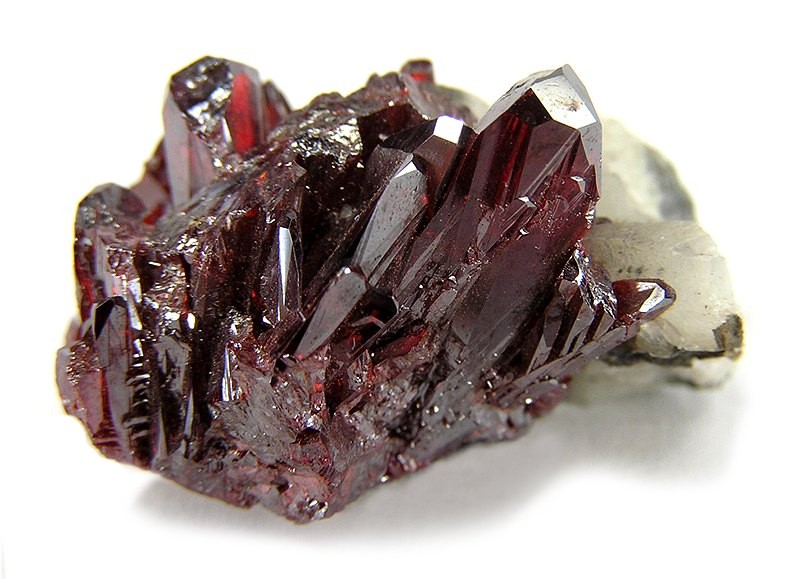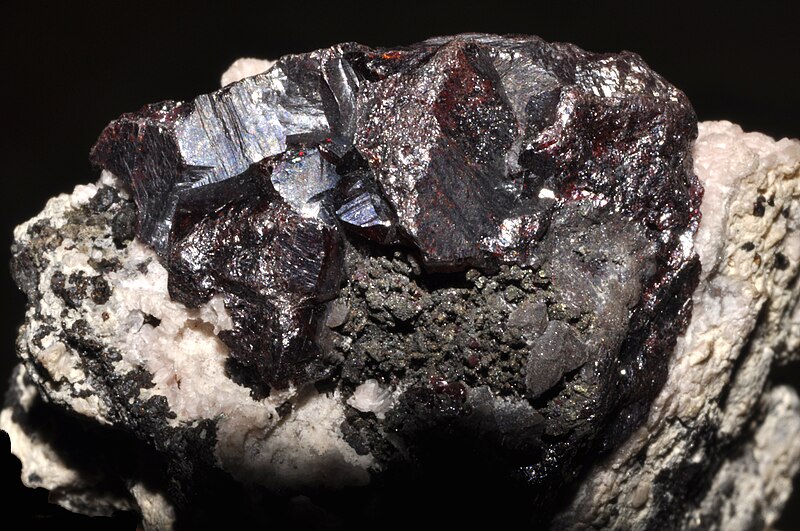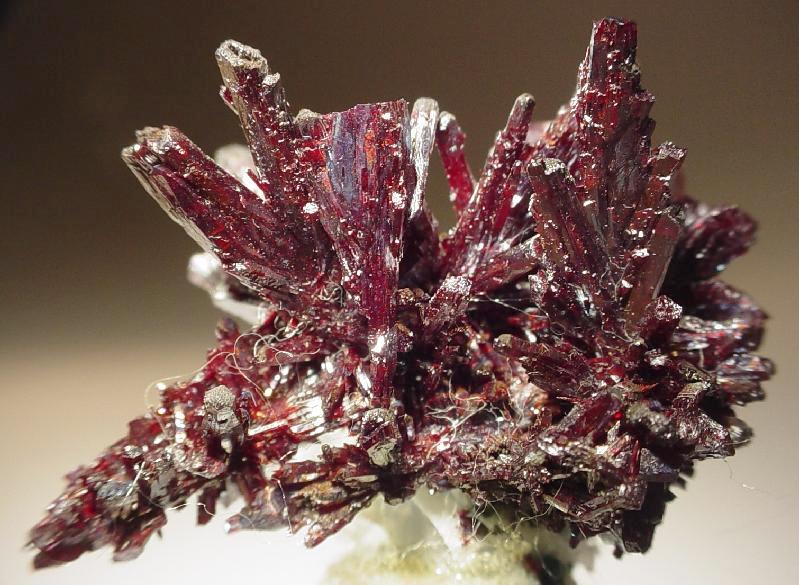
プルースタイト宝石:特性、意味、価値など
 プルースタイトは、重要な金属鉱石として知られる緋色の宝石です。プルースタイトは何の鉱石でしょうか?銀です!
プルースタイトは、重要な金属鉱石として知られる緋色の宝石です。プルースタイトは何の鉱石でしょうか?銀です!
プルースタイトは鉱物ですか?はい、プルースタイトは銀ヒ素硫化鉱物です。
プルースタイトは希少ですか?もちろんです。銀は鉱物に元々含まれる元素としては稀です。銀鉱物はファセットカットされることも稀で、魅力的な宝石になることも稀です。そのため、ルビーレッドのプルースタイトはコレクターの間で人気です。
今日は、プルースタイトの宝石と鉱物の特性、意味、歴史、価格などについて説明します。
 画像クレジット: Rob Lavinsky、 iRocks.com – CC-BY-SA-3.0
画像クレジット: Rob Lavinsky、 iRocks.com – CC-BY-SA-3.0
プルースタイトとは何ですか?
プルースタイトは、深紅色の希少な半貴石です。占星術的には、プルースタイトは射手座に良いとされています。
プルースタイトのニックネームは以下のとおりです。
ルビーシルバー
ルビー銀鉱石
ライトレッドシルバー
淡赤色の銀鉱石
ライトルビーシルバー鉱石
赤銀鉱石
ヒ素赤銀
ヒ素閃銀
サングレ・デ・トロ(スペイン語で「雄牛の血」)
注: プルースタイトの「ルビー」というニックネームは、その色のみを指しており、ルビーは別の鉱物です。
プルースタイトは言うまでもなく銀鉱石です。しかし、「ルビーシルバー」は、ポリベイサイト、ピアセサイト、ピラジライトを指すこともあります。ピラジライトは「ダークレッドシルバー」または「ダークレッドシルバー鉱石」とも呼ばれます。
ところで、プルースタイトの用途は何でしょうか?
プルースタイトの用途
プルースタイトの主な工業用途は銀の原料です。プルースタイトは歴史的に重要であったため、今日では最も一般的な銀鉱石(銀銀鉱)ではありませんが、それでもマイナーな鉱石です。
2022年現在、宝飾品や銀製品以外での銀の主な用途は、電子機器および電気部品(太陽エネルギーを含む)、触媒、金属はんだでした。
さらに、プルースタイトは合成され、色素レーザー光混合用に研究されています。
 画像クレジット: Rob Lavinsky、 iRocks.com – CC-BY-SA-3.0
画像クレジット: Rob Lavinsky、 iRocks.com – CC-BY-SA-3.0
プルースタイトの仕様と特徴
プルースタイト鉱物は銀、硫黄、ヒ素から構成されており、硫化塩鉱物に分類されます。
プルースタイトは、銀アンチモン硫化物ピラギライトと系列を形成します。非常に似ていますが、ピラギライトはより濃い赤色で、紫がかった赤色の縞模様があります。
ピラギライトは、キサントコナイトやピロスティルプナイトとともにプルースタイト鉱物グループに属します。キサントコナイトはプルースタイトと同じ組成ですが、単斜晶系の結晶構造をしています。
プルースタイト結晶は、水平方向に縞模様が見られることが多い。柱状結晶、菱面体結晶、および/または不等辺面体結晶(12個の不等辺三角形の面を持つ結晶)の形状をとることがある。一部の柱状結晶は、1つの不等辺面体結晶と1つの菱面体結晶の端を持つ。
双晶は一般的です。複数のプルースタイト結晶が塊状の集合体を形成したり、トリリング(3つの結晶が互いに重なり合った構造)を形成したり、互いに貫入し合ったりすることがあります。
プルースタイト鉱物は、密集した、被覆した、塊状の、粒状の、ブドウ状、または球状の形でも発生することがあります。
プルースタイトのプロパティの一覧:
モース硬度:2~2.5
色: 深紅(緋色、朱色、桜色)、濃い紫がかった赤、赤みがかった灰色、灰色、メタリックグレー
結晶構造:六方晶(三方晶)
光沢:アダマンタイトまたは亜金属光沢
透明性: 半透明から不透明、まれに透明。時間の経過とともに不透明になることがある。
屈折率:2.792-3.088
密度:5.51~5.64
胸の谷間:はっきりしている/良好
骨折:貝殻状または不均一/不規則
縞模様:緋色または朱色
発光:なし
多色性:血赤色および緋色で存在し、中程度から強い
複屈折:0.295-0.296
分散:弱い
光学現象:不可逆的なフォトクロミズム
「不可逆的なフォトクロミズム」とは何でしょうか?
 画像クレジット: 親ジェリー、パブリック ドメイン
画像クレジット: 親ジェリー、パブリック ドメイン
プルースティットの時代による変化
プルースタイトの注目すべき(しかし残念な)特性の 1 つはフォトクロミズムです。
フォトクロミズムとは、鉱物が光にさらされることで色が変化することです。アレキサンドライトのような色が変化する宝石とは異なり、フォトクロミック宝石は紫外線(太陽光など)の下でのみ色が変化し、その変化の速度は照射後数分から数時間まで様々です。
もう一つの重要な違いは、可逆的なフォトクロミズム(テネブレセンス)と不可逆的なフォトクロミズムです。テネブレセンスを持つ石(例:ハックマナイト)は、色を無限に変化させることができます。不可逆的なフォトクロミズムを持つ石(例:クンツァイト)は、光にさらされると永久に色が変化します。
銀を含むプルースタイトは不可逆的なフォトクロミズムを有し、光にさらされると色が濃くなり(最終的には黒くなります)、不透明度が増します。また、結晶の表面に鈍く暗い膜が形成されることもありますが、簡単な洗浄で除去できます。
プルースタイトは光に当たらなくても、時間の経過とともに徐々に黒ずんでいきます。これは、プルースタイトに含まれる銀原子がある程度流動性を持つため、内部で別の結晶、つまり濃い灰色のアカンサイトを形成し始めるためです。アカンサイトの存在が、徐々に色を変化させます。
これらすべての変化は、ピラギライトにも見られます。
精神的に、プルースタイトの意味は何ですか?
 画像クレジット: Rob Lavinsky、 iRocks.com – CC-BY-SA-3.0
画像クレジット: Rob Lavinsky、 iRocks.com – CC-BY-SA-3.0
プルースティットの意味と歴史
プルースタイトは、強さ、勇気、そして回復力を象徴しています。また、直感、自己認識、そして精神的な目覚めを表すこともあります。
初期の歴史
フランスの鉱物学者で地質学者のフランソワ・シュルピス・ブーダンは、プルースタイトが白鉄鉱とは異なる鉱物であることを初めて特定し証明したフランスの化学者ジョセフ・L・プルーストにちなんで、1832年にプルースタイトと命名しました。
プルースティットのモデル産地はチェコ共和国のヤーヒモフで、1945 年まではザンクト ヨアヒムスタールまたはヨアヒムスタールと呼ばれていました。この町には豊かな銀鉱山の歴史があります。
1516年に設立され、銀の豊富さからプラハに次いでボヘミアで2番目に人口の多い町になりました。
そこで採掘された銀の一部は、1520年からヨアヒムスターラー貨幣として鋳造された。この短縮形のターラーが、最終的にドルの由来となった。
チリ発見
1832年、チリの農民であり鉱山労働者でもあったフアン・ゴドイがチリのチャニャルシージョで銀鉱床を偶然発見し、チリの銀ラッシュが始まりました。
鉱夫たちは最終的にプルースタイトを発見し、その母岩が銀鉱石で「出血」していたことから、「雄牛の血」を意味するサングレ・デ・トロというニックネームを付けました。
プルースタイトの治癒特性
人気の赤いヒーリングストーンであるプルースタイトは、他の赤い宝石と同様に活力を与え、やる気を起こさせる特性があり、さらに効果的なルートチャクラストーンでもあります。
身体の治癒
プルースタイトの形而上学的特性には、以下に関連する身体的問題の治療が含まれると言われています。
前立腺
循環
感染症
腎臓と膀胱
閉経
感情的な癒し
感情面では、プルースタイトは勇気と真の目的への洞察をもたらすと言われています。また、豊かさを引き寄せ、心の平安を促し、感情のバランスを整える効果もあると言われています。
 画像クレジット: Maurizio Dini、 CC-BY-SA-3.0
画像クレジット: Maurizio Dini、 CC-BY-SA-3.0
プルースタイト宝石の特性
プルースタイト宝石の価値は希少性に加え、色、カット、クラリティ、透明度によって決まり、カラット重量もその価値に影響します。
色
プルースタイトの色は明るい赤から濃い赤まで様々で、黄色や紫がかった色合いを帯びることもあります。劣化した標本(光への曝露や経年劣化など)は黒く変色していることが多く、価値は低くなります。
プルースタイトの色の原因は、中バンドギャップ半導体によって引き起こされるため、色の起源に関するバンド理論に当てはまります。
カット
プルースタイトは希少で柔らかいため、 ファセットカットされたプルースタイトは希少です。その多くは、長方形の階段状、円形、または八角形です。
販売されているプルースタイトのほとんどは、原石(カットされていない)標本の状態で入手可能です。
明確さと透明性
宝石に含まれる目に見える内包物の度合いであるクラリティは、石の透明度と価値に影響を与えます。プルースタイトの中には、内部に亀裂や成長帯が見られるものもあります。
しかし、内包物は透明な標本にのみ見られ、透明度に関係なく価値があるほどに希少です。
カラット重量
現在コレクションや展示されているプルースタイト結晶からは、巨大なファセットカットの宝石が採れる可能性がありますが、すぐにカットされる可能性は低いでしょう。特に大きなファセットカットのプルースタイトの中には、10~12カラットのものもありました。
合成繊維
合成プルースタイトは研究に使用されるだけでなく、コレクションの中にファセットカットされた石として現れることもあります。
 画像クレジット: Rob Lavinsky、 iRocks.com – CC-BY-SA-3.0
画像クレジット: Rob Lavinsky、 iRocks.com – CC-BY-SA-3.0
プルースタイトの形成と起源
プルースタイトは、低温の晩期鉱物として熱水鉱床に形成されます。通常、酸化層(地下水面より上)または浅成層(地表近く)に見られます。
深成鉱物の形成は、降水が地中深くまで浸透し、一次硫化鉱物を酸化しながら硫酸と酸化金属溶液を形成することで起こります。これらの溶液はさらに酸化層へと進み、そこで一次鉱物と反応してプルースタイトのような二次鉱物を生成します。
地理的に、プルースタイトはどこで見つかりますか?
採掘場所
最高品質のプルースタイト結晶はチリ産で、特にチャニャルシージョ産が最もファセット加工しやすい素材です。チェコ共和国も依然として主要な産地です。
その他の重要な情報源としては、次のものがあります。
カナダ
ドイツ
フランス
イタリア
メキシコ
ペルー
米国 (カリフォルニア、コロラド、アイダホ、ネバダ)
 画像クレジット: Rob Lavinsky、 iRocks.com – CC-BY-SA-3.0
画像クレジット: Rob Lavinsky、 iRocks.com – CC-BY-SA-3.0
プルースティットの価格と価値
プルースタイトは鉱物としても宝石としても希少であるため、価格も一般的にそれを反映しています。しかし、ファセットカットされたプルースタイトは最も高価です。
ファセットカットされたプルースタイトの価格は、1カラットあたり約200ドルから1,200ドル、または約700ドルから1,900ドルの範囲です。
赤色の標本は、灰色から黒色のみの標本よりも高価です。
全体的に見ると、灰色の標本は通常30ドルから90ドル程度、赤色の標本は約150ドルから700ドル以上です。最高品質のコレクター向け標本は、1匹あたり2,500ドルから10,800ドル近くまで価格が変動します。
プルースタイトのケアとメンテナンス
まず、プルースタイトにはヒ素が含まれており、摂取すると有毒であることにご注意ください。有毒鉱物の取り扱いに関する安全上のヒントはいくつかありますが、最も重要なヒントは以下のとおりです。
プルースタイトを切断または研磨する場合は、プルースタイトの粉塵や煙を吸い込まないように適切な安全装置を着用してください。
プルースタイトを取り扱う際は手袋を着用し、使用後は手袋を廃棄するか、交差汚染を防ぐために指定された箱に保管してください。
石を口に入れる可能性のある人(子供やペットなど)の手の届かないところに保管してください。
プルースタイトをエリキシル剤の製造に使用しないでください。
プルースタイトは傷がつきやすいため、ヒ素を含む繊維が放出される危険性が高くなります。プルースタイトは密閉された展示ケースにのみ保管することをお勧めします。
宝石のお手入れとしては、プルースタイトの透明性と色を保つために、暗い場所(涼しい場所)に保管するのが最適です。多くのプルースタイトは時間の経過とともに必然的に黒ずんでいきますが、光や熱にさらされると、その変化が早まります。
手袋を着用し、低刺激性の石鹸、水、柔らかいマイクロファイバーの布でプルースタイトを洗浄できます。
プルースタイトを探しに?
銀を含む鉱物は数多くありますが、どれも希少です。プルースタイトは一見恐ろしい鉱物のように見えますが、適切な手入れをすれば、この美しい希少鉱物はどんなコレクターにとっても夢のような存在です。
Gemstone Encyclopedia検索
最新記事
レインボーラティスサンストーンは、様々な内包物によって3つのゴージャスな光学的効果を持つ長石の一種です。燃えるように鮮やかな色合いと格子模様が、コレクターにとって希少な宝石となっています。
12th Jan 2026
チューライトは、ゾイサイト鉱物ファミリーに属する、鮮やかなバラ色の色合いを示す希少なノルウェー産の宝石で、ジュエリーのセッティングやペンダントによく使用されます。
6th Jan 2026
記事のカテゴリ
How To's is where you will find helpful articles from gem Rock Auctions on how to cut gemstones, select gemstones and buy gemstones.
9記事数
